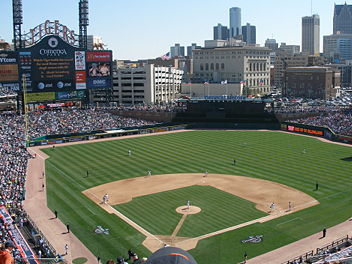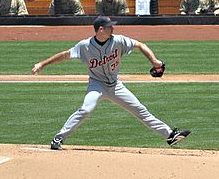
In 1998, the Tigers moved from the American League's Eastern Division, where they had been since divisions were created in 1969, to the Central Division, as part of a realignment necessitated by expansion. The Tigers were not an original member of the Central, which had been created in 1994.

The entrance sign of Comerica Park
In 2000, the team left Tiger Stadium, then tied with Fenway Park as the oldest active baseball stadium, in favor of the new Comerica Park. This capped an argument among Detroiters, lasting more than a decade, about whether or not a new stadium was needed to keep the club competitive.
Soon after it opened, Comerica Park drew criticism for its deep dimensions, which made it difficult to hit home runs; the distance to left-center field (395 ft), in particular, was seen as unfair to hitters. This led to the nickname "Comerica National Park."[20] The team made a successful bid to bring in slugger Juan Gonzalez from the Texas Rangers for the inaugural 2000 season at Comerica Park. Gonzalez hit a meager (for him) 22 home runs that season, and many cited Comerica Park's dimensions as a major reason he turned down multi-millions to re-sign with the club in 2001. In 2003, the franchise largely quieted the criticism by moving in the left-center fence to 370 feet (110 m), taking the flagpole in that area out of play, a feature carried over from Tiger Stadium. In 2005, the team moved the bullpens to the vacant area beyond the left-field fence and filled the previous location with seats.
In late 2001, Dave Dombrowski, former general manager of the 1997 World Series champion Florida Marlins, was hired as team president. In 2002, the Tigers started the season 0–6, prompting Dombrowski to fire the unpopular Smith, as well as manager Phil Garner. Dombrowski then took over as general manager and named bench coach Luis Pujols to finish the season as interim manager. The team finished 55–106. After the season was over, Pujols was let go.
Most losses in American League history (2003)
Main article: 2003 Detroit Tigers season
Dombrowski hired popular former shortstop Alan Trammell to manage the team in 2003. With fellow '84 teammates Kirk Gibson and Lance Parrish on the coaching staff, the rebuilding process began. In 2003, still playing with mostly players Smith had drafted or acquired, the Tigers shattered their 1996 mark for team futility by losing an American League-record 119 games. This eclipsed the previous AL record of 117 losses set by the 1916 Philadelphia Athletics, and was just .030 ahead of the 1916 A's .235 win percentage.[21] On August 30, 2003, the Tigers' defeat at the hands of the Chicago White Sox caused them to join the 1962 New York Mets (who were a first year expansion club) as the only modern MLB teams to lose 100 games before September. They avoided tying the 1962 Mets' modern MLB record of 120 losses only by winning five of their last six games of the season, including three out of four against the Minnesota Twins who had already clinched the Central Division (into which the Tigers had moved in 1998), and were resting their stars.
Mike Maroth went 9–21 for the 2003 Tigers and became the first pitcher to lose 20 games in more than 20 years.[22] Tigers' pitchers Maroth, Jeremy Bonderman (6–19), and Nate Cornejo (6–17) were #1, #2, and #3 in the major leagues in losses for 2003—the only time in major league history that one team has had the top three losers.
While the 2003 Tigers rank as the third worst team in major league history based on loss total, they fare slightly better based on winning percentage. Their .265 win percentage was the majors' sixth-worst since 1900. The Tigers went 43–119 that season, 47 games behind division-winner Minnesota.
Further information: List of worst MLB season records#Table of worst teams
Rebuilding the franchise (2004–06)
Although the 2003 season was a complete morass, Dombrowski gave Trammell a chance to finish the remaining two years of his contract over the 2004 and 2005 seasons. Under Dombrowski, the Tigers demonstrated a willingness to sign marquee free agents. In 2004, the team signed or traded for several talented but high-risk veterans, such as Fernando Viña, Iván Rodríguez, Ugueth Urbina, Rondell White and Carlos Guillén, and the gamble paid off. The 2004 Tigers finished 72–90, a 29-game improvement over the previous season, and the largest improvement in the American League since Baltimore's 33-game improvement from 1988 to 1989. However, the team was still sub-.500.
Prior to the 2005 season, the Tigers spent a large sum for two prized free agents, Magglio Ordóñez and Troy Percival. On June 8, 2005, the Tigers traded pitcher Ugueth Urbina and infielder Ramón Martínez to the Philadelphia Phillies forPlácido Polanco (and later signed him for 4 years). The Tigers stayed on the fringes of contention for the American League wild card for the first four months of the season, but then faded badly, finishing 71–91. The collapse was perceived as being due both to injuries and to a lack of player unity; Rodriguez in particular was disgruntled, taking a leave of absence during the season to deal with a difficult divorce. Trammell, though popular with the fans, took part of the blame for the poor clubhouse atmosphere and lack of continued improvement, and he was fired at the end of the season.
A highlight of the 2005 campaign was Detroit's hosting of the Major League Baseball All-Star Game, its first since 1971. In the Home Run Derby, Rodriguez finished second, losing to the Phillies' Bobby Abreu.
In October 2005, Jim Leyland, who managed Dombrowski's 1997 World Series–winning Marlins club, replaced Trammell as manager; two months later, in response to Troy Percival's '05 arm problems, closer Todd Jones, who had spent five seasons in Detroit (1997–2001), signed a two-year deal to return to the Tigers. Veteran left-hander Kenny Rogers also joined the Tigers from Texas in late 2005. These offseason additions set the stage for the resurgence of "Tiger Fever" in Detroit and its environs the following year.
The Return of the Tigers: 2006 American League Champions
Main article: 2006 Detroit Tigers season
After years of futility, the 2006 season showed signs of hope. The impressive rookie campaigns of eventual American League Rookie of the Year Justin Verlander, centerfielder Curtis Granderson, and flamethrowing relief pitcher Joel Zumaya, coupled with a well-publicized early-season tirade by Leyland, helped the team explode and quickly rise to the top of the AL Central. The team reached a high point when they were 40 games over .500, but a second half swoon started to raise questions about the team's staying power. On August 27, a 7–1 victory over the Cleveland Indians gave the Tigers their 82nd victory and their first winning season since 1993. On September 24, the Tigers beat the Kansas City Royals 11–4 to clinch their first playoff berth since 1987. A division title seemed inevitable. All that was required was one win in the final five games of the season, which included three games against the Royals, whom the Tigers had manhandled much of the season. However, the Tigers lost all five games and the division title went to the Minnesota Twins. The Tigers were the AL wild card winner, the first time a team from the AL Central had won the honor.
The playoffs saw the Tigers beat the heavily favored New York Yankees 3 games to 1 in the ALDS and sweep the Oakland Athletics in the 2006 ALCS, thanks to a walk-off home run in Game 4 by right fielder MagglioOrdóñez. They advanced to theWorld Series, where they lost to the underdog St. Louis Cardinals in five games.
Falling short (2007-2010)

Tigers opening day 2007; view from section 324
The Tigers would field competitive teams over the next four years, but struggles in the second half of all four years kept them from repeating their 2006 playoff appearance.
2007
Main article: 2007 Detroit Tigers season
In 2007, the Tigers returned 22 of 25 players from their 2006 World Series roster, and traded for outfielder Gary Sheffield, who had been a part of the 1997 Marlins World Series team managed by Jim Leyland. In addition to acquisitions, Dombrowski developed a productive farm system. Justin Verlander and Joel Zumaya, the most notable rookie contributors to the 2006 team, were followed by Andrew Miller, who was drafted in 2006 and called up early in the 2007 campaign, and minor-leaguer Cameron Maybin, an athletic five-tool outfielder ranked #6 in Baseball America's 2007 Top-100 Prospects.[23] The Tigers suffered from injuries in the 2007 season, especially to their pitching staff. Kenny Rogers did not start until late June because of surgery to remove a blood-clot in his throwing arm. Other pitchers who were injured included Tim Byrdak, Fernando Rodney, Jair Jurrjens and Joel Zumaya.
The 2007 Tigers had the best record in baseball in mid-July, but lost a few players to injuries and started to play poorly in the second half and fade from contention. This pattern of good starts followed by a poor second half would be repeated over the next three seasons. The Tigers gave up their division lead to the Cleveland Indians in early September and were officially eliminated from playoff competition on September 26, 2007, when the New York Yankees clinched a wild card berth. The Tigers, at 88-74, finished second in the AL Central.
2008
Main article: 2008 Detroit Tigers season

Justin Verlander, June 2008
Going into the 2008 season, the franchise traded for prominent talent in Edgar Rentería (from the Atlanta Braves) and Miguel Cabrera and Dontrelle Willis (from the Florida Marlins). However, the Tigers (who now boasted the second-highest team payroll in the majors at over $138 million[24]) began the regular season by losing seven straight games. The Tigers climbed back, and at the midway point of the season, they were 42–40. In the end, the team finished miserably, slumping to a 74–88 record. Justin Verlander finished with his worst season as a pro, as he went 11–17 with a 4.84 ERA. The Tigers also lost closer Todd Jones to retirement on September 25, 2008. Despite the disappointing season, the team set an attendance record in 2008, drawing 3,202,654 customers to Comerica Park.
2009
Main article: 2009 Detroit Tigers season
The Tigers started 2009 very hot, quickly gaining the lead in the AL Central and keeping it for much of the year. This was fueled primarily by the combination of pitching and defense.
The Tigers acquired starter Edwin Jackson from the 2008 AL Champion Tampa Bay Rays, and called up rookie and former #1 draft pick Rick Porcello. Jackson was outstanding in the first half, making his first All-Star team, while Porcello was solid most of the year, posting a 14–9 record with a 3.96 ERA and displaying grit and maturity beyond his 20 years of age. Tigers ace Justin Verlander bounced back from an off 2008 to win 19 games. He posted a 3.45 ERA and led the AL in strikeouts (269) to finish third in the AL Cy Young balloting. Fernando Rodney assumed the closer role in spring training, replacing the retired Todd Jones. Rodney responded with 37 saves in 38 tries, while Bobby Seay, Brandon Lyon and young Ryan Perry shored up the middle relief that plagued the team in 2007–08.



















